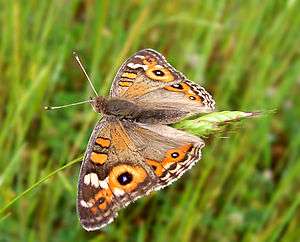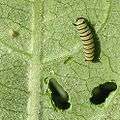Lepidopteran Pests
< Horticulture| Caterpillars | |
|---|---|
 | |
| Type: | Insect |
| Order: | Lepidoptera |
| Metamorphosis: | Complete |
| Damaging stages: | Larval |
| Vulnerable stages: | All |
| Diseases vectored: | Rarely act as vectors |
The order Lepidoptera is the second largest order of insects and includes the butterflies, skippers, and moths. Members of the order are referred to as lepidopterans, and a person who collects or studies this order is referred to as a Lepidopterist. The order has more than 180,000 species in 127 families and 46 superfamilies. It is second only to Coleoptera (the beetles) in the number of described species. The word "lepidoptera" means "scaly-wing", from the ancient Greek words lepidos and pteron.
Description
Lepidopterans undergo complete metamorphosis going through a four-stage life cycle of egg - larva / caterpillar - pupa/chrysalis -imago/adult. The larvae have a toughened (sclerotized) head capsule, chewing mouthparts, and a soft body, that may have hair-like or other projections, 3 pairs of true legs, and additional prolegs (up to 5 pairs). They can be confused with the larvae of sawflies. Lepidopteran larvae can be differentiated by the presence of crochets on the prolegs which are absent in the Symphyta (sawflies). Most caterpillars are herbivores, but a few are carnivores (some eat ants or other caterpillars) and detritivores (Dugdale, 1996).
Adults have two pairs of membranous wings covered, usually completely, by minute scales. In some species, wings are reduced or absent (often in the female but not the male). Antennae are prominent. In moths, males frequently have more feathery antennae than females, for detecting the female pheromones at a distance. Adult mouth parts, called a proboscis, are adapted for sucking nectar. Some species have reduced mouthparts (some species do not feed as adults), and others have them modified to pierce and suck blood or fruit juices (some Noctuids) (Scoble, 1992).
See also: difference between a butterfly and a moth.
-

Painting of butterfly life cycle
-

Head of Pyralid moth, showing tongue and compound eye
-
Lepidoptera wing.jpg
Close up of wing, showing scales
-
.jpg)
moth
-

Egg of Monarch butterfly Danaus plexippus
-

Larva of Monarch on milkweed
-

Chrysalis of Monarch
-
Butterfly at Lincoln Zoo 2 by igowerf.jpg
Adult Monarch nectaring
Control
Families of Lepidoptera
.jpg)
There are about 130 families in this order with variations depending on the taxonomic treatment (see the family template box at the bottom of this section).
The Lepidoptera are divided into several suborders, the largest being Ditrysia.
Several other classifications of lepidopteran families are used in older literature. These include the Rhopalocera (club-horned) consisting of what are commonly called butterflies and the Heterocera (varied-horned) consisting of the moths. These categories are however, not valid taxonomic groups.
Another non-standard classification separates the Lepidoptera into Microlepidoptera for the smaller species (mostly moths) and Macrolepidoptera for the larger species.
Butterflies
- Hesperioidea
- Papilionoidea
Moths
- Acanthopteroctetoidea
- Alucitoidea
- Axioidea
- Bombycoidea
- Calliduloidea
- Choreutoidea
- Cossoidea
- Drepanoidea
- Epermenioidea
- Eriocranioidea
- Galacticoidea
- Gelechioidea
- Geometroidea
- Gracillarioidea
- Hedyloidea
- Hepialoidea
- Heterobathmioidea
- Hyblaeoidea
- Immoidea
- Incurvarioidea
- Lasiocampoidea
- Lophocoronoidea
- Micropterigoidea
- Mimallonoidea
- Mnesarchaeoidea
- Neopseustoidea
- Nepticuloidea
- Noctuoidea
- Palaephatoidea
- Pterophoroidea
- Pyraloidea
- Schreckensteinioidea
- Sesioidea
- Simaethistoidea
- Thyridoidea
- Tineoidea
- Tischerioidea
- Tortricoidea
- Urodoidea
- Whalleyanoidea
- Yponomeutoidea
- Zygaenoidea
External links
- Lepidopterology.com
- Moths and Butterflies of Europe and North Africa
- British Butterflies and Moths
- Photography of European Butterflies and Moths
- Butterflies and Moths in the Netherlands
- Lepidoptera of North America
- Lepidoptera in online insect museum
- Butterflies of Asturias - Spain
- Historic Moth illustrations
References
- Dugdale, JS, 1996. Natural history and identification of litter-feeding Lepidoptera larvae (Insecta) in beech forests, Orongorongo Valley, New Zealand, with especial reference to the diet of mice (Mus musculus). Journal of The Royal Society of New Zealand, Volume 26, Number 2, pp 251-274
- Grimaldi, D, and MS Engel, 2005. Evolution of the Insects. Cambridge University Press.
- Kristensen, NP (Ed.). 1999. Lepidoptera, Moths and Butterflies. Volume 1: Evolution, Systematics, and Biogeography. Handbuch der Zoologie. Eine Naturgeschichte der Stämme des Tierreiches / Handbook of Zoology. A Natural History of the phyla of the Animal Kingdom. Band / Volume IV Arthropoda: Insecta Teilband / Part 35: 491 pp. Walter de Gruyter, Berlin, New York.
- Nye, IWB & DS Fletcher, 1991. Generic Names of Moths of the World. Volume 6: xxix + 368 pp. Trustees of the British Museum (Natural History), London.
- Scoble, MJ 1995. The Lepidoptera: form, function and diversity. Oxford, UK: The Oxford University Press; 404 p.
- Firefly Encyclopedia of Insects and Spiders, edited by Christopher O'Toole, ISBN 1-55297-612-2, 2002